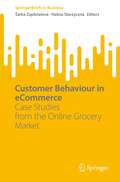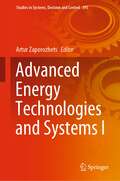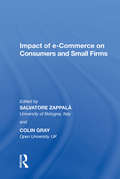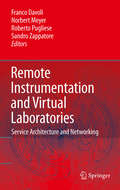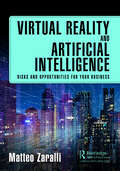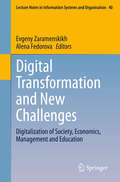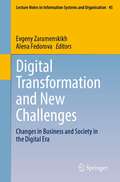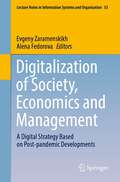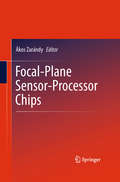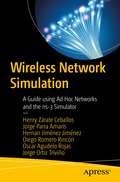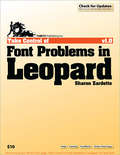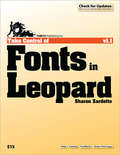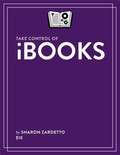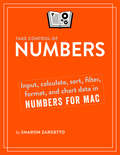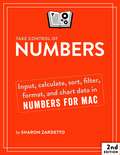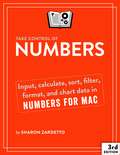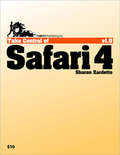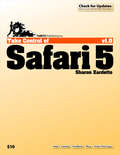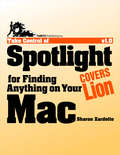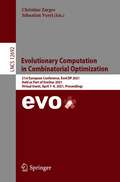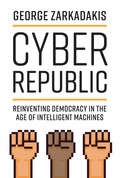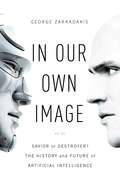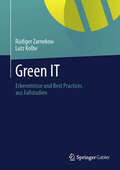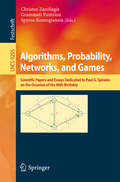- Table View
- List View
Customer Behaviour in eCommerce: Case Studies from the Online Grocery Market (SpringerBriefs in Business)
by Šárka Zapletalová Halina StarzycznáOnline shopping is undergoing significant changes around the globe, evolving in the food and non-food segments alike. Representing a vital distribution channel that reaches countless customers, sales from online shopping have long-since exceeded USD 1000 billion per year and are growing steadily. This book is intended for general readers and professionals interested in companies’ strategic orientation in connection with their online format and building and strengthening customer loyalty. In this regard, their business strategies are not considered in their full scope and complexity; instead, the book focuses more narrowly on the relationship between business strategy, buying behavior and customer loyalty.
Advanced Energy Technologies and Systems I (Studies in Systems, Decision and Control #395)
by Artur ZaporozhetsThis book focuses on modern technologies and systems for solving problems in the energy sector. It is shown that bioenergy is one of the promising areas of energy development. The book collected the experience of scientists from many countries in the research of renewable energy. The advantages of renewable energy are general availability, renewability, environmental friendliness. The analysis carried out by the authors shows the current state of renewable energy in the world, its trends and prospects. New measuring systems are presented, which can become the basis for measuring the thermal characteristics of various types of fuels, including biofuels, insulating materials, enclosing structures, etc. System for monitoring of grainy biomass comminution with the use of genetic algorithms has been presented and described. New technologies for the construction of power plants based on renewable energy sources have been proposed and investigated.
Impact of e-Commerce on Consumers and Small Firms
by Salvatore ZappalaThe change from old to new technologies has fundamentally changed the relationship between the consumer and the firm. This book is at the frontier of behavioural research into how these new commercial realities are borne out in practice, examining the adoption of e-commerce by small firms and the transactional phenomenon that entails access to the Internet. In analyzing the process of e-commerce adoption and why e-commerce actors behave as they do, its coverage includes the adoption of information and communication technologies (ICT) by small firms; the use of ICT applications to support marketing and sales transactions; and the factors that influence consumers' online purchasing decisions.
Remote Instrumentation and Virtual Laboratories
by Sandro Zappatore Norbert Meyer Roberto Pugliese Franco DavoliAccessing remote instrumentation worldwide is one of the goals of e-Science. The task of enabling the execution of complex experiments that involve the use of distributed scientific instruments must be supported by a number of different architectural domains, which inter-work in a coordinated fashion to provide the necessary functionality. These domains embrace the physical instruments, the communication network interconnecting the distributed systems, the service oriented abstractions and their middleware. The Grid paradigm (or, more generally, the Service Oriented Architecture -- SOA), viewed as a tool for the integration of distributed resources, plays a significant role, not only to manage computational aspects, but increasingly as an aggregator of measurement instrumentation and pervasive large-scale data acquisition platforms. In this context, the functionality of a SOA allows managing, maintaining and exploiting heterogeneous instrumentation and acquisition devices in a unified way, by providing standardized interfaces and common working environments to their users, but the peculiar aspects of dealing with real instruments of widely different categories may add new functional requirements to this scenario. On the other hand, the growing transport capacity of core and access networks allows data transfer at unprecedented speed, but new challenges arise from wireless access, wireless sensor networks, and the traversal of heterogeneous network domains. The book focuses on all aspects related to the effective exploitation of remote instrumentation and to the building complex virtual laboratories on top of real devices and infrastructures. These include SOA and related middleware, high-speed networking in support of Grid applications, wireless Grids for acquisition devices and sensor networks, Quality of Service (QoS) provisioning for real-time control, measurement instrumentation and methodology, as well as metrology issues in distributed systems.
Virtual Reality and Artificial Intelligence: Risks and Opportunities for Your Business
by Matteo ZaralliTechnology is rapidly transforming the way people learn and train, and the integration of virtual reality (VR) and artificial intelligence (AI) could be the next big breakthrough. With the advent of Web 3.0 and the Metaverse, there are endless possibilities for creating immersive and engaging learning environments. However, there is also a need to address the risks and challenges that these technologies present.This book explores the risks and opportunities of VR and AI for coaching and training, with an eye toward the emerging trends of Web 3.0 and the Metaverse. Coaching and training have become increasingly important for companies seeking to develop and retain talent. With the advent of VR and AI technology, there is an opportunity to create immersive and engaging learning environments that could greatly enhance the learning experience. However, there are also risks associated with the use of these technologies, such as data privacy and cybersecurity.This book provides an in-depth analysis of the risks and opportunities of VR and AI for coaching and training, to help startup and business executives understand how to use these technologies responsibly and effectively. We need a new perspective. The book discusses the intersection of various major subjects and topics: business, innovation, technology, and philosophy in terms of critical thinking. The transition we are experiencing through this new Intelligent Revolution is very important, and soon everyone will witness the shift from e-learning to v-learning.
Digital Transformation and New Challenges: Digitalization of Society, Economics, Management and Education (Lecture Notes in Information Systems and Organisation #40)
by Evgeny Zaramenskikh Alena FedorovaThis book gathers the best papers presented at the first conference held by the Russian chapter of the Association for Information Systems (AIS). It shares the latest insights into various aspects of the digitalization of the economy and the consequences of transformation in public administration, business and public life. Integrating a broad range of analytical perspectives, including economic, social and, technological, this interdisciplinary book is particularly relevant for scientists, digital technology users, companies and public institutions.
Digital Transformation and New Challenges: Changes in Business and Society in the Digital Era (Lecture Notes in Information Systems and Organisation #45)
by Evgeny Zaramenskikh Alena FedorovaThis book gathers the best papers presented at the second conference held by the Russian chapter of the Association for Information Systems (AIS), which took place in Yekaterinburg, Russian Federation, in December 2019. It shares the latest insights into various aspects of the digitalization of the economy and the consequences of transformation in public administration, business and public life. Integrating a broad range of analytical perspectives, including economic, social and technological, this interdisciplinary book is particularly relevant for scientists, digital technology users, companies and public institutions.
Digitalization of Society, Economics and Management: A Digital Strategy Based on Post-pandemic Developments (Lecture Notes in Information Systems and Organisation #53)
by Evgeny Zaramenskikh Alena FedorovaThis book gathers the best papers presented at the third conference held by the Russian chapter of the Association for Information Systems (AIS), which took place in December 2021. The book shows the path to digital transformation of organizations and how possible obstacles can be overcome. With contributions from digital experts in both academia and IT and management, it presents practical frameworks and planning tools for new business models. It offers executives at the forefront of strategic initiatives a guide on how to implement key disruptive technologies in their organizations while following an established digital strategy. Overall, the book is relevant for scientists, digital technology users, companies and public institutions.
Focal-Plane Sensor-Processor Chips
by Ákos ZarándyFocal-plane sensor-processor imager devices are sensor arrays and processor arrays embedded in each other on the same silicon chip. This close coupling enables ultra-fast processing even on tiny, low power devices, because the slow and energetically expensive transfer of the large amount of sensory data is eliminated. This technology also makes it possible to produce locally adaptive sensor arrays, which can (similarly to the human retina) adapt to the large dynamics of the illumination in a single scene This book focuses on the implementation and application of state-of-the-art vision chips. It provides an overview of focal plane chip technology, smart imagers and cellular wave computers, along with numerous examples of current vision chips, 3D sensor-processor arrays and their applications. Coverage includes not only the technology behind the devices, but also their near- and mid-term research trends.
Wireless Network Simulation: A Guide using Ad Hoc Networks and the ns-3 Simulator
by Henry Zárate Ceballos Jorge Ernesto Parra Amaris Hernan Jiménez Jiménez Diego Alexis Romero Rincón Oscar Agudelo Rojas Jorge Eduardo Ortiz TriviñoLearn to run your own simulation by working with model analysis, mathematical background, simulation output data, and most importantly, a network simulator for wireless technology. This book introduces the best practices of simulator use, the techniques for analyzing simulations with artificial agents and the integration with other technologies such as Power Line Communications (PLC).Network simulation is a key technique used to test the future behavior of a network. It’s a vital development component for the development of 5G, IoT, wireless sensor networks, and many more. This book explains the scope and evolution of the technology that has led to the development of dynamic systems such as Internet of Things and fog computing. You'll focus on the ad hoc networks with stochastic behavior and dynamic nature, and the ns-3 simulator. These are useful open source tools for academics, researchers, students and engineers to deploy telecommunications experiments, proofs and new scenarios with a high degree of similarity with reality. You'll also benefit from a detailed explanation of the examples and the theoretical components needed to deploy wireless simulations or wired, if necessary.What You’ll LearnReview best practices of simulator usesUnderstand techniques for analyzing simulations with artificial agentsApply simulation techniques and experiment designProgram on ns-3 simulatorAnalyze simulation resultsCreate new modules or protocols for wired and wireless networksWho This Book Is ForUndergraduate and postgraduate students, researchers and professors interested in network simulations. This book also includes theoretical components about simulation, which are useful for those interested in discrete event simulation DES, general theory of simulation, wireless simulation and ns-3 simulator.
Take Control of Font Problems in Leopard
by Sharon ZardettoLearn how to solve your font problems today! Are you suffering from mysterious font problems using Microsoft Office, the Adobe Creative Suite, or other programs in Mac OS X Leopard? Help is at hand, with troubleshooting steps and real-world advice that help you solve problems fast. If you've experienced seemingly inexplicable trouble with characters displaying incorrectly, being unable to type a particular character, fonts missing from Font menus, Font Book crashing, or Character Palette misbehaving, turn to font expert Sharon Zardetto for help. Read this ebook to find the answers to questions such as:Where do fonts belong on my hard drive? In what order do fonts load, and what happens if I have multiple copies? How do I use Safe Mode to troubleshoot a font problem? How do I use another user account to troubleshoot a font problem? How do I move a font file that doesn't want to move? Why does bold and italic text look double printed in Word? Why does my font's name have brackets around it in the InDesign font list? Why can't I install a PostScript Type 1 font? Why doesn't the Input menu show up in my menu bar? People keep telling me to "just delete the caches." What are they? Where are they? Why does deleting them solve a font problem?
Take Control of Fonts in Leopard
by Sharon ZardettoInstall, organize, and use fonts with ease in Leopard! In this essential ebook, long-time Mac author Sharon Zardetto reveals all the details about how fonts work in Mac OS X 10.5 Leopard. She explains what folders your fonts reside in, in what order they load, and how to deal with font duplication. You'll also learn the ins and outs of different font installation methods; how to use Font Book to manage, validate, and organize fonts; how to make the most of character-rich Unicode fonts; and more. Whether you work in a font-intensive profession, use Unicode fonts for non-Roman languages, or want to wrangle the numerous fonts that have ended up on your Mac, you need this ebook. Read this ebook to learn the answers to questions such as: What's new with fonts and Font Book in Leopard? What types of fonts can I use with Leopard? Which fonts can I remove from my system safely? How can I best organize the fonts stored on my Mac? How can I figure out what characters are available in a Unicode font? What is the logic and organization for Adobe's various CS products? How are fonts from Microsoft Office 2004 and 2008 stored? How should I handle fonts from Apple's iLife and iWork suites? How can I minimize font trouble when sharing documents across platforms? What aspects of using fonts have changed between Mac OS X 10.5 and 10.5.5?
Take Control of iBooks
by Sharon ZardettoIndulge your inner bibliophile with Apple's iBooks ebook reader!You know how to read a book, but do you know how to read and manage an entire library in iBooks, Apple's ebook-reading app for OS X Mavericks and iOS 7? On its surface, iBooks appears simple, but the more you add to your library, the more your questions will pile up. Get answers, plus learn about ebook-reading features that are not immediately obvious. If you need advice on collecting and reading ebooks in the Mavericks version of iBooks, want to know how iBooks stores and syncs your ebooks, or want to become more adept with iBooks on an iPad, iPhone, or iPod touch, this ebook is for you.Whether you're catching up on your favorite authors, poring over textbooks, or perusing work-related documents, self-described readaholic and Mac expert Sharon Zardetto teaches you the ABCs of iBooks. Sharon helps you optimize your onscreen reading environment, use the navigational controls (which differ depending on which type of ebook you're reading!), manage bookmarks, highlight important passages, make notes, and more. You'll also learn about auto-downloading and re-downloading purchases from Apple's iBooks Store, and where to find ebooks outside the iBooks Store.As you turn the virtual pages of Take Control of iBooks you'll read about:Ebook file formats: Here at Take Control, we often hear from people who aren't sure about the differences among the major ebook file formats--PDF, EPUB, Mobipocket, and Multi-Touch. If you're struggling with these basics (the difference between a hardback and a paperback is easier to understand), Sharon sets you straight, and helps you understand how the format of an ebook affects its behavior and features in iBooks.Mavericks mysteries: Discover what iBooks on your Mavericks Mac does with any ebooks that were previously in iTunes, where your library is located, and how to add EPUB, PDF, and Multi-Touch ebooks to iBooks. Synchronizing details: Find directions for syncing your Books library among your Apple devices. In addition to keeping copies of your ebooks on all your devices, you can sync your custom collection names and your position within any given book, as well as your bookmarks, highlights, and notes.Book acquisition: Whether you buy from Apple's iBooks Store, buy from a third party that sells ebooks in EPUB or PDF format (such as Take Control!), or make your own titles (such as with Apple's free iBooks Author--see Take Control of iBooks Author for help), you'll find out how to populate iBooks with your ebooks.Collection management: If you don't have time to "shelve" your ebooks, don't worry, because Sharon teaches techniques for taking advantage of iBooks' built-in organization and search function. But, the persnickety arrangers among us will learn how to further organize an iBooks library.Control your reading environment: Just as you may read best in the real world with the right lighting (and a bowl of grapes on hand, with a cat at your feet), you can also optimize your onscreen setup. You'll find tips for adjusting the font and type size, changing the page color, reading full-screen on the Mac, and even how to best "turn" the page.Enjoy the "e" in ebook: All those tiny electrons running around in your device can do more than display text on a screen. Sharon describes how to highlight passages, make in-book notes, insert virtual bookmarks, look up a selection in the dictionary (or on the Web--great for looking up a historical character or event that's mentioned in passing!) and more. A special chapter, "Explore Multi-Touch Books," guest-written by ebook expert Michael E. Cohen, helps you fully understand what's so special about Apple's Multi-Touch format and makes sure you can enjoy the special features, such as Study Cards, available in those ebooks.
Take Control of Numbers
by Sharon ZardettoGet serious with Numbers, Apple's powerful spreadsheet for the Mac!Apple's Numbers has become a grown-up spreadsheet (and it's free on every Mac sold since October 2013!), but many of us still haven't learned even the basics, much less been able to take advantage of its surprisingly deep collection of features.With the advice in this 330-page ebook, you'll learn to input, calculate, sort, filter, format, and chart your data with ease, as author Sharon Zardetto guides you through the basics all the way to power-user features like conditional highlighting, custom data formats, and star ratings. Richly illustrated with hundreds of annotated screenshots, the ebook also includes a hands-on example spreadsheet you can use to try what you're learning, plus a special tutorial chapter that helps you put it all together. Of course, you can also treat the book as a reference, using the Quick Start to focus on a topic of interest.The book covers Numbers 3.5, which works on any Mac running OS X 10.10 Yosemite.You'll learn how to...Handle the basics:Input data into a table.Choose the best chart type for your data.Add, modify, and position shapes, such as arrows, comments, and text boxes.Import/export from Excel, text, CSV, and older versions of Numbers.Set up page numbers and other header/footer information for printing.See what you want to see:Know what to expect when you sort by column.Hide and show columns.Merge and unmerge cells.Create rules that filter data to display only specific rows.Set up and view interactive charts.Make formulas:Work fluidly in the formula editor to create formulas.Make formulas from the tear-off tokens on the Quick Calc bar.Nimbly use various types of cell references in formulas.Understand how to use IF, TRUE, and FALSE in formulas.Take charge of logical operators (AND, OR, NOT) in formulas.Concatenate and break apart text.Strip extra spaces out of data.Find medians, modes, ranks, percentiles, and more.Create clever formulas that can:Calculate a sales discount based on whether a total is over or under a certain amount.Sort seemingly unsortable data, such as items described as Poor, Good, or Excellent.Take a column of cells, with each cell containing a full name, and move all the last names into a different column.Apply formatting:Add and remove grid lines and cell borders.Work with a cell's background fill.Format a chart so it looks fabulous.Set up conditional highlighting that appears only when data meets certain criteria.Ensure accurate data entry with cell formats like sliders, menus, and checkboxes.Use and create templates.Format faster with character, paragraph, list, shape, and table styles.
Take Control of Numbers
by Sharon ZardettoWork quickly, confidently, and effectively in Numbers 6 with Sharon Zardetto's detailed instructions. Input, calculate, sort, filter, format, and chart your data with ease as you learn not just the basics but also special tricks and power-user features.
Take Control of Numbers
by Sharon ZardettoWork quickly, confidently, and effectively in Numbers 11 for Mac with Sharon Zardetto's detailed instructions. Input, calculate, sort, filter, format, and chart your data with ease as you learn not just the basics but also special tricks and power-user features.
Take Control of Safari 4
by Sharon ZardettoRead this book to learn answers to questions like these: How do I load six Web pages at once?Now that I've loaded six pages, how do I best work with them?What are all the keyboard shortcuts for working with tabs?How do I bookmark a page I want to return to?How do I import Firefox bookmarks?I have 1,042 bookmarks. Is there a sensible way to search or organize them?What are the default keyboard shortcuts for the bookmarks bar?Can I search for text on the currently active Web page?How do I erase my history to prevent someone snooping through it?Where does Safari store Web site user names and passwords?Help! However Safari stored my password, it doesn't work any more!How do I use Safari to read RSS headlines from different sites?How do I "snip" a Web page to make it into a Dashboard widget?
Take Control of Safari 4
by Sharon ZardettoRead this book to learn answers to questions like these: How do I load six Web pages at once? Now that I've loaded six pages, how do I best work with them? What are all the keyboard shortcuts for working with tabs? How do I bookmark a page I want to return to? How do I import Firefox bookmarks? I have 1,042 bookmarks. Is there a sensible way to search or organize them? What are the default keyboard shortcuts for the bookmarks bar? Can I search for text on the currently active Web page? How do I erase my history to prevent someone snooping through it? Where does Safari store Web site user names and passwords? Help! However Safari stored my password, it doesn't work any more! How do I use Safari to read RSS headlines from different sites? How do I "snip" a Web page to make it into a Dashboard widget?
Take Control of Safari 5
by Sharon ZardettoGo beyond basic Web browsing in Safari 5 with this definitive guide from Mac expert Sharon Zardetto! You'll find detailed coverage of new Safari 5 features like support for extensions and the Reader. You'll get essential advice on smart ways customize your Safari environment, and learn key browsing techniques, including how to keep track of where you've been, load multiple Web pages at once, search both the Web and the content of pages you're reading, fill out forms automatically, keep track of passwords, download files, use RSS to keep up with your favorite Web sites, and manage your Web-browsing history.Read this book to learn answers to questions like these:How do I load six Web pages at once?Now that I've loaded six pages, how do I best work with them?How do I bookmark a page I want to return to?How do I import Firefox bookmarks?I'm a pack rat. How should I organize and access my bookmark collection?I forgot to bookmark a great page I saw yesterday. How can I find it again?How can I read a multi-page Web article without clicking to switch pages?How do I find the word "marshmallow" in the text of a huge Web page?How do I erase my history to keep my housemate from snooping through it?Where does Safari store Web site user names and passwords?Help! What do I do when a stored password stops working?How do I use Safari to read RSS headlines from different sites?How do I install the My eBay Manager extension?How can I turn Safari into a "clipping service" that grabs RSS headlines from different sites when they mention certain topics?
Take Control of Spotlight for Finding Anything on Your Mac
by Sharon ZardettoYou'll learn these search-related techniques: Improve search accuracy by limiting Spotlight to searching just where you want. Reduce result clutter by choosing which categories should appear in the Spotlight menu. Learn what to do when the Spotlight menu doesn't list an item that it should be able to find. Use criteria bars (and even the elusive Boolean bars!) to create complex search queries. Bypass criteria bars by typing complex, powerful queries in any Spotlight search field. Build Boolean searches with AND, OR, and NOT to narrow your search results precisely. In addition, you'll find out how to make your files even easier to find with these techniques: Customize a file's metadata. Employ free third-party utilities to give your files useful, searchable tags. Set up sophisticated smart folders that provide dynamic file organization. In these days of terabyte drives, your Mac has enormous storage capacity, and you may have many thousands of files squirreled away (we don't even want to admit to how many hundreds of thousands of files are filling up our disks!). But with the Spotlight expertise you'll gain from this ebook, you'll be able to retrieve anything on your Mac, no matter how deeply it's buried or how specific you need to make your search (how about every GarageBand song in the key of E-flat, or every graphic that's smaller than 500 by 500 pixels?).
Evolutionary Computation in Combinatorial Optimization: 21st European Conference, EvoCOP 2021, Held as Part of EvoStar 2021, Virtual Event, April 7–9, 2021, Proceedings (Lecture Notes in Computer Science #12692)
by Christine Zarges Sébastien VerelThis book constitutes the refereed proceedings of the 21st European Conference on Evolutionary Computation in Combinatorial Optimization, EvoCOP 2021, held as part of Evo*2021, as Virtual Event, in April 2021, co-located with the Evo*2021 events: EvoMUSART, EvoApplications, and EuroGP. The 14 revised full papers presented in this book were carefully reviewed and selected from 42 submissions. They cover a wide spectrum of topics, ranging from the foundations of evolutionary algorithms and other search heuristics to their accurate design and application to combinatorial optimization problems. Fundamental and methodological aspects deal with runtime analysis, the structural properties of fitness landscapes, the study of core components of metaheuristics, the clever design of their search principles, and their careful selection and configuration. Applications cover problem domains such as scheduling, routing, search-based software engineering and general graph problems. The range of topics covered in this volume reflects the current state of research in the fields of evolutionary computation and combinatorial optimization.
Cyber Republic: Reinventing Democracy in the Age of Intelligent Machines
by George ZarkadakisScience and tech expert George Zarkadakis presents an indispensable guide to making liberal democracies more inclusive, and the digital economy more equitable in the coming Fourth Industrial Revolution.Around the world, liberal democracies are in crisis. Citizens have lost faith in their government; right-wing nationalist movements frame the political debate. At the same time, economic inequality is increasing dramatically; digital technologies have created a new class of super-rich entrepreneurs. Automation threatens to transform the free economy into a zero-sum game in which capital wins and labor loses. But is this digital dystopia inevitable? In Cyber Republic, George Zarkadakis presents an alternative, outlining a plan for using technology to make liberal democracies more inclusive and the digital economy more equitable. Cyber Republic is no less than a guide for the coming Fourth Industrial Revolution.
In Our Own Image: Savior or Destroyer? The History and Future of Artificial Intelligence
by George ZarkadakisA timely and important book that explores the history and future, as well as the societal and ethical implications, of Artificial Intelligence as we approach the cusp of a fourth industrial revolution Zarkadakis explores one of humankind's oldest love-hate relationships—our ties with artificial intelligence, or AI. He traces AI's origins in ancient myth, through literary classics like Frankenstein, to today's sci-fi blockbusters, arguing that a fascination with AI is hardwired into the human psyche. He explains AI's history, technology, and potential; its manifestations in intelligent machines; its connections to neurology and consciousness, as well as—perhaps most tellingly—what AI reveals about us as human beings. In Our Own Image argues that we are on the brink of a fourth industrial revolution—poised to enter the age of Artificial Intelligence as science fiction becomes science fact. Ultimately, Zarkadakis observes, the fate of AI has profound implications for the future of science and humanity itself.
Green IT
by Rüdiger Zarnekow Lutz KolbeDie zunehmende Verbreitung und steigende Abhängigkeit von Informationstechnologien und darauf aufsetzender Dienste führen zu bisher unberücksichtigten ökologischen und sozialen Herausforderungen. Das IT-Management sieht sich aufgrund dieser Entwicklung mit neuen Anforderungen seitens der Geschäftsbereiche, der Kunden und der Mitarbeiter konfrontiert. Wachsender Energieverbrauch beim Betrieb und der Nutzung von IT-Infrastrukturen bei kontinuierlich steigenden Rechenleistungen sowie die immer kürzer werdenden Lebenszyklen von IT-Produkten erfordern neue strategische Konzepte für das IT-Management. Vor diesem Hintergrund werden in diesem Buch Best Practices im Bereich Green IT vorgestellt. Anhand von Fallstudien, die gemeinsam mit Autoren aus der Praxis verfasst wurden, sollen die Bedeutung und der Umsetzungsstand einer Nachhaltigkeitsorientierung im IT-Management aufgezeigt werden. In diesem Zusammenhang dokumentieren die Fallstudien aktuelle Bemühungen der Organisationen im Rahmen einer Green IT. Ziel des Buches ist es, IT-Organisationen anwendungsorientierte Konzepte und Modelle für die praktische Umsetzung zur Verfügung zu stellen.
Algorithms, Probability, Networks, and Games: Scientific Papers and Essays Dedicated to Paul G. Spirakis on the Occasion of His 60th Birthday (Lecture Notes in Computer Science #9295)
by Christos Zaroliagis Grammati Pantziou Spyros KontogiannisThis Festschrift volume is published in honor of Professor Paul G. Spirakis on the occasion of his 60th birthday. It celebrates his significant contributions to computer science as an eminent, talented, and influential researcher and most visionary thought leader, with a great talent in inspiring and guiding young researchers. The book is a reflection of his main research activities in the fields of algorithms, probability, networks, and games, and contains a biographical sketch as well as essays and research contributions from close collaborators and former PhD students.
